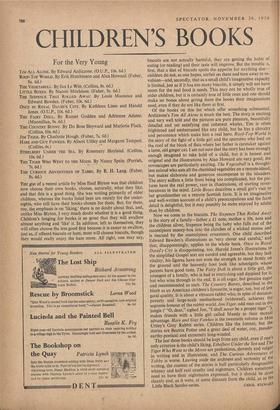CHILDREN'S BOOKS
For the Very Young
TIM ALL ALONE. By Edward Ardizzone. (O.U.P., 10s. 6d.) THE VEGETABULL. By Jan Le Witt. (Collins, 8s. 6d.) THE FAIRY Dom- By Rumer Godden and Adrienne Adams. (Macmillan, 9s. 6d.) THE COUNTRY BUNNY. By Du Bose Heyward and Marjorie Flack. (Collins, 10s. 6d.) JIM TIGER. By Charlotte Hough. (Faber, 7s. 6d.) HARE AND GUY FAWKES. By Alison Uttley and Margaret Tempest. (Collins, 4s.) ETHELBERT UNDER THE SEA. By Rosemary Hoyland. (Collins, 10s. 6d.) THE TIGER WHO WENT TO THE MOON. By Nancy Spain. (Parrish, 7s. 6d.) THE CURIOUS ADVENTURES OF TABBY. By E. H. Lang. (Faber, 8s. 6d.) THE gist of a recent article by Miss Enid Blyton was that children now choose their own books, choose, naturally, what they like, and that this is a good thing. She was writing primarily of older children, whereas the books listed here are mainly for the under- eights, who still have their books chosen for them. But, for them, too, the emphasis is on 'liking,' there is no doubt about that, and, unlike Miss Blyton, I very much doubt whether it is a good thing. Children's longing for books is so great that they will swallow almost anything and 'like' it. In addition, left to themselves, they will often choose the less good first because it is easier to swallow, just as, if offered biscuits or ham, most will choose biscuits, though they would really enjoy the ham more. All right, one may say,
biscuits are not actually harmful, they are getting the habit of eating (or reading) and their taste will improve. But the trouble ;s, first, that a diet of biscuits spoils the appetite for anything else— children do not, as one hopes, surfeit on them and turn away in re- vulsion—and, secondly, that as a small child's imaginative capacity is limited, just as if it has too many biscuits, it simply will not have room for the real food it needs. This may not be wholly true of older children, but it is certainly true of little ones and one should make no bones about giving them the books their imaginations need, even if they do not like them at first.
Of the books on this list which offer something substantial, Ardizzone's Tim All Alone is much the best. The story is exciting and very well told and the pictures are pure pleasure, beautifully detailed and yet satisfying and coherent wholes. Tim is often frightened and embarrassed like any child, but he has a chivalry and persistence which make him a real hero. Roof-Top World is the story of the fight of a little girl and the sparrows who feed on the roof of the block of flats where her father is caretaker against a lame, old ginger cat. I am not sure that the story has been strongly enough imagined to take hold of a child, but it is honest and original and the illustrations by Alan Howard are very good; the townscapes are particularly exciting. The Vegetabull is a thought- less animal who eats all the cherished vegetables on a remote island, but makes elaborate and generous recompense to the islanders. The story suffers a little from being too complicated, but the pic- tures have the real power, rare in illustrations, of starting rever- berations in the mind. Little Boxes describes a small girl's visit to her grandmother on a remote Scottish farm. It is an imaginative and well-written account of a child's preoccupations and the farm detail is delightful, but it may possibly be more enjoyed by adults than by children.
Now we come to the biscuits. The Sixpence That Rolled Away is the story of a family—father a £1 note, mother a 10s. note and the children silver, Sixpence being the baby who falls out of the mantelpiece money-box into the clutches of a wicked mouse and is rescued by the mantelpiece ornaments. One child described Edward Bawden's illustrations as 'very clever and careful,' and that, disappointingly, applies to the whole book. Once in Royal David's City is disappointing, too. Harold Jones's illustrations to the simplified Gospel text are careful and agreeable, but they lack vitality; his figures have not even the strength to stand firmly on the ground and the heavenly host look like schoolgirls whose parents have good taste. The Fairy Doll is about a little girl, the youngest of a family, who is bad at everything and despised for it, but who wins through in the end. It is all sugar, but genuine sugar and recommended as such. The Country Bunny, described in the blurb as an American children's favourite, is sugar, too, but of less good quality. It is about a virtuous rabbit who, in spite of derision, poverty and large-scale motherhood (widowed), achieves the supreme honour of the rabbit world. Jim Tiger, odd man out in the jungle ('"0, dear," sighed Jim, "I shall never be a proper tiger"'). makes friends with a little girl called Mandy to their mutual advantage. Flare and Guy Fawkes is the twentieth volume in Miss Uttley's Grey Rabbit series. Children like the format, but the stories are Beatrix Potter and a great deal of water, coy, pseudo- earthy-poetical and extremely long-winded. The last three books should be kept from any child, even if one's only criterion is the child's liking. Ethelbert Under the Sea and The Tiger Who Went to the Moon axe pretentious, slovenly and vulgar in writing and in illustration, and The Curious Adventures of Tabby is worse. Leaving aside the archness and verbosity of the writing, the content of the stories is half particularly disagreeable whimsy and half real cruelty and nightmare. Children sometimes need to have their nightmares expressed, but it should be done cleanly and, as it were, at some distance from the child, as in the


















































 Previous page
Previous page